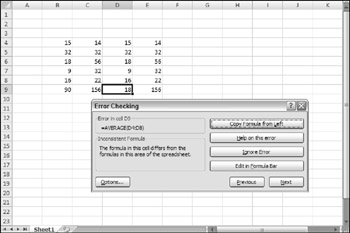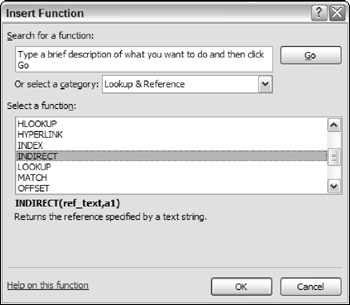Formulas, Functions, and Names
Formulas, Functions, and Names
Formulas are what make a spreadsheet a spreadsheet. Excel has some advanced formula- related features that are worth knowing. They enable you to write array formulas, use an intersection operator, include links, and create megaformulas (my term for a lengthy and incomprehensible - but very efficient - formula).
| CROSS-REFERENCE | Chapter 3 covers formulas and presents lots of tricks and tips. |
Excel also has some useful auditing capabilities that help you identify errors or track the logic in an unfamiliar spreadsheet. To access these features, use the commands in the Formulas ![]() Formula Auditing group .
Formula Auditing group .
You may find the Formulas ![]() Formula Auditing
Formula Auditing ![]() Error Checking command useful. It will scan your worksheet and identify possibly erroneous formulas. In Figure 2-14, Excel identifies a possibly inconsistent formula and provides some options.
Error Checking command useful. It will scan your worksheet and identify possibly erroneous formulas. In Figure 2-14, Excel identifies a possibly inconsistent formula and provides some options.

Figure 2-14: Excel can monitor your formulas for possible errors.
Worksheet functions enable you to perform calculations or operations that would otherwise be impossible . Excel provides a huge number of built-in functions.
The easiest way to locate the function that you need is to use the Insert Function dialog box, as shown in Figure 2-15. Access this dialog box by clicking the Insert Function button on the formula bar (or by pressing Shift+F3). After you select a function, Excel displays its Function Arguments dialog box, which assists with specifying the function's arguments.

Figure 2-15: The Insert Function dialog box is the best way to insert a function into a formula.
| NEW | In Excel 2007, the Analysis ToolPak functions are now built-in. In other words, you can use these function even if the Analysis ToolPak add-in is not installed. |
| CROSS-REFERENCE | Excel also lets you create your own worksheet functions by using VBA. For details about this powerful feature, see Chapter 10. |
A name is an identifier that enables you to refer to a cell, range, value, formula, or graphic object. Formulas that use names are much easier to read than formulas that use cell references, and it's much easier to create formulas that use named references.
| CROSS-REFERENCE | I discuss names in Chapter 3. As you can see there, Excel handles names in some unique ways. |
EAN: 2147483647
Pages: 319